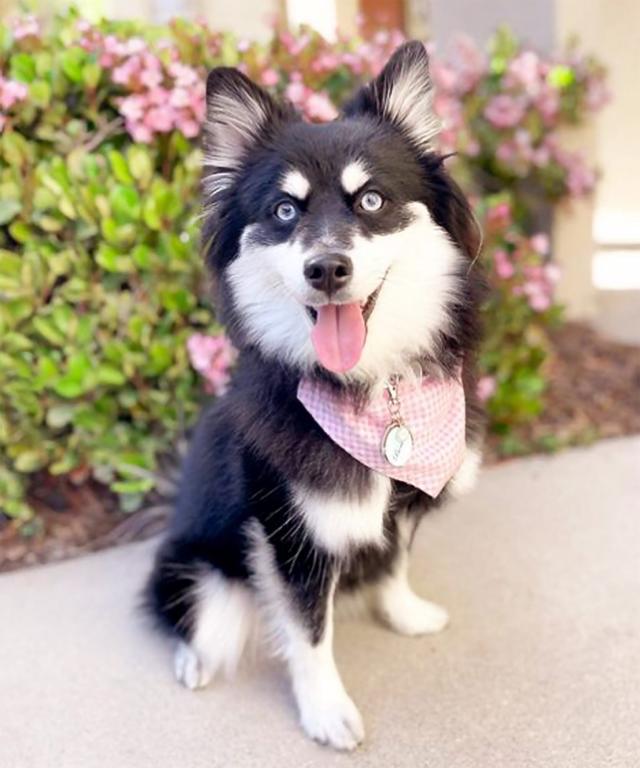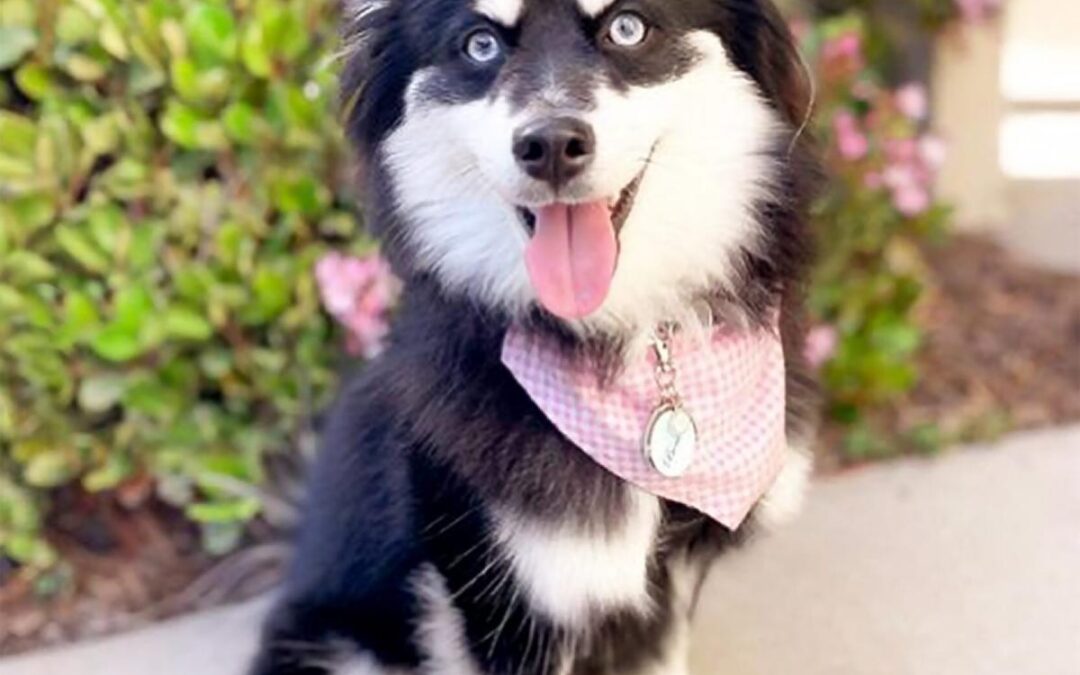Pomskies are a crossbreed of Pomeranians and Siberian Huskies, whereas Pomeranians are a purebred toy breed. Pomskies tend to be larger and have a mix of both breeds’ traits.
Choosing between a Pomsky and a Pomeranian depends on your lifestyle and preferences. The Pomsky, a hybrid, combines the Pomeranian’s small size and the Husky’s striking appearance, often resulting in a medium-sized dog with a plush coat and varying eye colors.
Known for their intelligence and playful nature, Pomskies can be a good fit for active owners who appreciate a trainable yet spirited companion. On the other hand, the Pomeranian is smaller, ideal for those with limited space, and possesses a bold, confident personality that belies its diminutive stature. Both breeds manifest strong loyalty and affection towards their owners, making either a potential match for someone seeking a loving pet. Deciding which suits you best will come down to considerations such as living space, exercise requirements, and grooming commitments.

Credit: www.reddit.com
Meet The Contenders: Pomsky And Pomeranian
Picture this: small, fluffy, and full of personality. Now imagine having to choose between two of the cutest breeds known for their charming characteristics: the Pomsky and the Pomeranian. One, a mixture of Pomeranian and Siberian Husky, brings a unique blend to the table. The other, a purebred wonder, has captured hearts for generations. Let’s dive into their worlds and compare these adorable challengers!
Origin And Breed History
The Pomsky, a designer dog, is a recent addition to the world of canines. A cross between a Pomeranian and a Siberian Husky, this breed emerged within the last decade, gaining rapid popularity. Breeders aimed to blend the Husky’s majestic appearance with the Pomeranian’s diminutive size.
In contrast, the Pomeranian, originating from the Pomerania region between modern-day Poland and Germany, boasts a history spanning centuries. Once larger sled dogs, they were bred down in size and became favorites among royalty, including Queen Victoria.
Physical Appearances Compared
| Feature | Pomsky | Pomeranian |
|---|---|---|
| Size | Medium (10-15 inches) | Small (6-7 inches) |
| Weight | 15-30 pounds | 3-7 pounds |
| Fur | Thick, double-coated | Long, fluffy |
| Eyes | Almond-shaped, can have Husky’s blue eyes | Dark, round |
| Ear Shape | Pointed, standing erect | Small, erect |
Their flagship trait is the fur that requires regular grooming. While both breeds share a plush coat, the Pomsky’s is often denser due to the Husky lineage. Pomeranians are known for their iconic fox-like faces and buoyant gait, while Pomskies exhibit a balance between the Husky’s striking look and the Pomeranian’s petite stature.
Size And Space: Making Room For Your Pet
When you’re thinking about welcoming a furry friend into your home, size matters. Whether you live in a spacious house or a cozy apartment, knowing the space requirements for a Pomsky versus a Pomeranian is key. It’s not just about how much room they’ll take up on your couch, but also about the energy levels and daily exercise needs of these adorable pets. Let’s unpack the differences in size and the best living environments for each breed.
Comparing Weight And Height
Dogs come in all shapes and sizes, and this stands true for Pomskies and Pomeranians. A Pomsky, being a mix between a Pomeranian and a Siberian Husky, can vary quite a bit in size. Typically, they weigh between 20 and 30 pounds and stand 10 to 15 inches tall at the shoulder. Pomeranians, on the other hand, are much smaller, weighing a dainty 3 to 7 pounds, with a height of 6 to 7 inches. Here’s a quick glance:
| Breed | Weight | Height |
|---|---|---|
| Pomsky | 20-30 lbs | 10-15 in |
| Pomeranian | 3-7 lbs | 6-7 in |
Suitability For Apartment Living
Apartment living has its challenges and triumphs. Pomeranians are perfect for smaller spaces; they’re petite and adaptable. Their small frames make a compact living space more manageable. Pomskies can adapt to apartment living too, but their larger size and high energy levels mean they need more room to roam and play. Exercise is crucial — daily walks, play sessions, and mental stimulation keep them happy.
- Pomeranians: Ideal for apartments; need moderate exercise.
- Pomskies: Better in larger spaces; require more exercise and stimulation.
Whichever pet you choose, remember that every animal needs love and a comfortable space to call home. Understanding the space each breed needs can help you create a loving, forever home.
Temperament And Behavior: Furry Personalities
When choosing a fluffy companion, personality matters as much as appearance. Pomskies and Pomeranians charm families with unique temperaments. Understanding these can lead to a harmonious home. Let’s delve into the traits and behaviors of these adorable breeds.
Pomsky Traits And Behaviors
- Energetic playmates: Pomskies are a bundle of joy, bursting with energy and ready for fun activities or long walks.
- Intelligent: They inherit intelligence from their Husky and Pomeranian lineage, which makes them quick learners.
- Social butterflies: Pomskies enjoy being around people and do well with other pets if socialized early.
- Loyal: They form strong bonds with their families, often shadowing their favorite person at home.
- Vocal: Pomskies may inherit the Husky’s howl or Pomeranian’s bark, loving to express themselves.
Pomeranian Traits And Behaviors
- Confident: Despite their small size, Pomeranians have a big-dog demeanor, showing bravery and confidence.
- Friendly: They are affectionate and love to cuddle, making them great lap dogs.
- Alert: Pomeranians are always curious, keeping a watchful eye on their surroundings.
- Independent: Sometimes, they enjoy their own space and can entertain themselves.
- Communicative: They are quite vocal and will alert you with their yaps if they sense anything amiss.
Both breeds shine with distinct personalities that suit different lifestyles. The Pomsky fits active families, while the Pomeranian is perfect for those seeking a small, confident friend. Each breed brings joy with its unique temperament and behavior.
Grooming And Maintenance: Fur Care 101
Caring for your dog’s coat is essential for their comfort and health.
Whether you’re a proud owner of a fluffy Pomsky or a charming Pomeranian, knowing how to maintain their fur will keep them happy and looking their best.
Let’s dive into the specifics of coat care for these adorable breeds.
Coat Care And Shedding
Pomskies and Pomeranians boast thick double coats, which means they experience shedding.
Their plush fur requires regular attention to prevent mats and tangles. Brushing several times a week is a must.
Here’s a breakdown of what to expect with each breed.
| Breed | Shedding Level | Brushing Frequency |
|---|---|---|
| Pomsky | High | 3-5 times a week |
| Pomeranian | Medium to High | 2-4 times a week |
Grooming Requirements And Tips
A good grooming routine keeps your pet looking great.
It also saves your home from a fur invasion. Start with the right tools: a slicker brush, shedding blade, and detangling spray.
- Regular washing with dog-specific shampoo keeps their coat clean.
- Use a conditioner to add moisture and ease in removing loose hair.
- Include ear cleaning and nail trimming in their grooming routine.
Note: Always be gentle. The grooming experience should be positive for your furry friend.
With these tips and a bit of patience, your Pomsky or Pomeranian will look paw-fect!
Training And Intelligence: Who’s The Top Dog?
Are you pondering over Pomskies and Pomeranians?
Both breeds sparkle with intelligence, but their training needs differ.
Let’s dive into which canine companion stands out in the training arena.
Trainability And Learning Curve
The Pomsky, a mix of Pomeranian and Siberian Husky, is smart but can be stubborn.
Their independent streak means they need consistent training from an early age.
In contrast, the Pomeranian is eager to please and quick to learn.
Their smaller size and keen attention make training sessions often more manageable.
Mental Stimulation Needs
Pomskies inherit the Husky’s energy and need for mental challenges.
They thrive on puzzles, games, and new tricks to keep their active minds engaged.
Pomeranians, while also bright, have less intense mental exercise needs.
Short, fun training activities can keep their sparky intellects satisfied.
| Aspect | Pomsky | Pomeranian |
|---|---|---|
| Trainability | Higher effort needed | More receptive to training |
| Learning Curve | Gentle patience required | Quicker learner |
| Mental Stimulation | High needs for engagement | Less demanding |
Remember, positive reinforcement works best for both breeds.
- Reward good behavior
- Provide plenty of affection
- Be patient and consistent
With the right approach, training your fluffy friend becomes a rewarding journey
Exercise Needs: Keeping Up With Canine Energy
Both Pomskies and Pomeranians bring a burst of energy to your daily life. Understanding their exercise needs is vital. It ensures they stay happy and healthy. Let’s dive into what keeps these furry friends moving with joy.
Pomsky Activity Levels
Pomskies are energetic mixes, inheriting vigor from Husky ancestors. They require regular exercise to maintain their zest for life. Daily walks and play sessions are a must. This blend of vigor and endurance makes them ideal for active owners.
- Long walks or jogging sessions
- Interactive play with toys
- Dog park visits for socializing
- Brain games to tire them out mentally
Pomeranian Activity Levels
Pomeranians may be small, but their energy levels are surprisingly high. Though they need less exercise than Pomskies, consistency is key. Short daily walks and playtime will suffice. Their petite size makes them great for indoor games and activities.
| Activity Type | Frequency | Duration |
|---|---|---|
| Daily walks | 1-2 times | 15-20 minutes |
| Playtime | Daily | Varies |
| Training sessions | Few times a week | 5-10 minutes |
Health And Longevity: Wellness Watch
When you look at the adorable faces of Pomsky and Pomeranian dogs, their health and lifespan are key facts to know. These fluffy friends bring joy to our lives, so understanding their wellness is essential. This section explores their common health issues, life expectancy, and ways to keep them thriving.
Common Health Concerns
Pomskies and Pomeranians share some health conditions while having unique challenges of their own.
- Dental Issues: Regular teeth cleaning helps prevent tooth decay.
- Eye Problems: Check their eyes often to catch issues early.
- Joint Problems: Keep them active, but be gentle on their joints.
Pomskies, a mix of Huskies and Pomeranians, can inherit health concerns such as:
- Allergies
- Heart conditions
- Patella Luxation
Pomeranians may face these health risks:
- Collapsed Trachea
- Skin Issues
- Hip Dysplasia
Life Expectancy And Preventive Care
Understanding average life spans helps plan for a healthy future. Regular vet visits are the key to longevity.
| Breed | Life Expectancy |
|---|---|
| Pomsky | 13-15 years |
| Pomeranian | 12-16 years |
Follow these preventive care steps:
- Annual check-ups
- Vaccinations on time
- Healthy diet
- Regular exercise
- Dental hygiene
Early detection of diseases can extend your dog’s life. Keep an eye on their behavior and maintain a caring relationship with your vet.

Credit: www.yahoo.com
Puppy Love: Costs And Considerations
Bringing a furry friend into your life sparkles with joy. Yet, before you welcome a Pomsky or Pomeranian, let’s explore the financial side. This crucial step ensures your pup gets a blissful start. Here, we break down what you need to know about the initial outlay and the ongoing expenses of raising these lovable breeds.
Initial And Ongoing Costs
Pomsky and Pomeranian puppies are more than just cuddles. They need vet visits, food, and toys. Start-up costs can be surprising. You’ll need bowls, a bed, and more. Here’s a clear look at the expenses:
| Item | Pomsky | Pomeranian |
|---|---|---|
| Initial Price | $1000-$3000 | $500-$1500 |
| Vet Visits (Year 1) | $200-$500 | $200-$500 |
| Essentials | $200-$400 | $200-$400 |
Monthly costs follow suit. Food, grooming, and insurance pile up. Plan for $50-$100 each month.
Choosing A Reputable Breeder
Trustworthy breeders mean healthier, happier pups. They ensure your Pomsky or Pomeranian has the best start in life. Use these points to pick the right breeder:
- Look for health clearances and vaccinations.
- Visit the breeding site to check the environment.
- Meet the puppy’s parents when possible.
- Seek reviews and ask for references.
Pick a breeder who prioritizes the well-being of their dogs. They should answer your questions with ease. Your pup deserves a strong beginning, and it starts with a good breeder.
In The Hearts Of Families: Real-life Stories
The bond between a pet and its family is unique and heartwarming. Within this intimate circle, the stories of adoption are as diverse and lovely as the breeds themselves. The Pomsky and the Pomeranian, with their distinct personalities and sizes, find a special place in homes worldwide. Today we dive into real-life stories, the cherished moments these canines have brought to families. We unravel the tapestry of relationships between humans and these furry friends, as families open up about their lives with Pomskies and Pomeranians.
Adoption Stories And Testimonials
- Sarah’s Surprise: A birthday wish granted with a Pomsky pup, named Oreo.
- Martin Family: A Pomeranian named Ginger, filling their home with laughter.
- Jason’s Journey: A Pomsky, Zeus, becomes a boy’s best adventure buddy.
Every story reflects the beginning of a new chapter for both the family and their canine companion. A table of shared accounts lays out exactly what makes each breed special:
| Family Name | Pomsky | Pomeranian |
|---|---|---|
| The Clarks | Loyal and playful | Tiny but mighty |
| The Nguyens | Energetic bundle of joy | Cuddly furball |
| The Smiths | Friendly with kids | Feisty comedian |
The Joy They Bring To Families
The presence of a Pomsky or Pomeranian in a home spreads joy like wildfire. Smiles grow wider, laughter rings louder, and every day sparkles with a bit more magic. The stories families share capture this enchanting effect:
- Katie’s Comfort: Her Pomsky as a serene anchor during tough times.
- Leo’s Growth: Learning responsibility by caring for his tiny Pomeranian.
- The Wilsons’ Wonderland: Their Pomeranian orchestrates the household’s daily fun.
Each narrative bursts with testimonies of resilience, companionship, and unconditional love. Whether it’s a Pomsky’s boundless energy or a Pomeranian’s affectionate embrace, the stories confirm that these breeds hold a special role within families’ hearts.
Making Your Choice: Paw In Hand
Choosing between a Pomsky and a Pomeranian is like picking your favorite star in the sky, both are dazzling companions ready to light up your life. The decision rests in your palm, figuring out which furry friend complements your lifestyle best. Let’s explore the best fit for your personal puzzle.
Assessing Your Lifestyle Compatibility
Your daily routine is a key puzzle piece in this decision. A Pomsky is a mix of a Pomeranian and a Siberian Husky. Larger than Pomeranians, they require more space and exercise. Here are some points to help you check the compatibility:
- Space: Pomskies need room to roam, while Pomeranians fit in smaller spaces.
- Exercise: Can you commit to long walks? Pomskies love them, Pomeranians need less.
- Time: Pomskies crave attention and activity. Pomeranians are also playful, yet more independent.
The Final Verdict: Which Is Right For You?
| Pomsky | Pomeranian |
| Enjoys large, active families | Prefers quieter environments |
| Thrives with yard space | Adapts well to apartment living |
| Needs daily exercise | Requires modest activity |
Is your home bustling with activity, and do you have the zest for outdoor adventures? A Pomsky might be your perfect match. Do you seek a compact, cuddly companion for your cozy apartment? Then a Pomeranian may be the paw-fect choice. Listen to your heart, consider your daily life, and your perfect pet will become clear.
:max_bytes(150000):strip_icc()/shiranian-in-leaves-lemony_cricket1513-1-48768c08e8184bd1a46f7d1389b97bd6.jpg)
Credit: www.dailypaws.com
Frequently Asked Questions On Pomsky Vs Pomeranian
What Are The Cons Of The Pomsky?
Pomskies often suffer from separation anxiety. These dogs can be expensive and have high grooming needs. They’re prone to inheriting genetic issues from both Pomeranian and Husky breeds. Pomskies also require extensive exercise and may not suit small living spaces. Their behavior can be unpredictable.
Why Is My Pomsky Aggressive?
Your Pomsky might show aggression due to lack of training, fear, territorial behavior, pain, or inadequate socialization. Addressing these root causes with consistent training and a vet check-up can help manage aggressive behavior.
Why Are Pomsky Puppies So Expensive?
Pomsky puppies are expensive due to their designer breed status, combining Pomeranian and Husky traits. Limited breeders and high demand further inflate their cost. Their unique appearance and small size contribute to their premium price.
Are Pomskies Good House Dogs?
Pomskies are known to be good house dogs due to their affectionate nature and adaptable size. These energetic and intelligent pets typically get along well with families.
Conclusion
Deciding between a Pomsky and a Pomeranian isn’t easy. Both breeds boast charm and charisma that can win any heart. Consider your lifestyle, space, and time for grooming before choosing. Whether you seek a playful companion or a regal presence, either breed will fill your life with joy.
Remember, the perfect dog is the one that complements your life seamlessly.

